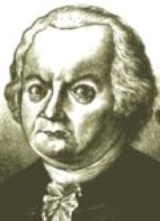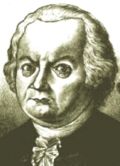
Johann Gottlob Leidenfrost
Encyclopedia
Johann Gottlob Leidenfrost (November 27, 1715 – December 2, 1794) was a German
doctor
and theologian who first described the scientific phenomenon eponym
ously named the Leidenfrost effect
.
 Johann Gottlob Leidenfrost was born on November 27, 1715 in Rosperwenda in the County of Stollberg
Johann Gottlob Leidenfrost was born on November 27, 1715 in Rosperwenda in the County of Stollberg
, Germany
. His father, Johann Heinrich Leidenfrost, was a well-known minister. Little is known of Leidenfrost's life prior to the start of his academic career.
Leidenfrost first attended the University of Gießen where he followed in his father's footsteps by studying theology
. He soon switched his academic concentration to medicine
, following that career path in his subsequent attendance at the University of Leipzig and the University of Halle
.
In 1741 he was awarded a doctorate in medicine largely based on a well-received treatise on the study of the movement of the human body, entitled On the Harmonious Relationship of Movements in the Human Body. After the conclusion of his academic studies, Leidenfrost spent some years traveling and took a post as a field physician in the first Silesian War.
In 1743 Leidenfrost was offered and accepted a professorship at University of Duisburg
. In 1745 he married a local Duisburg
woman, Anna Cornelia Kalckhoff. Johann and Anna had seven children together, including Johanna Ulricke (1752–1819), who was later the wife of the noted German theologian, Christian Krafft. In addition to teaching medicine
, physics
and chemistry
at the University of Duisburg, Leidenfrost also functioned as the university's rector, all the while maintaining a private medical practice.
In 1756, Leidenfrost became a member of the Berlin Academy of Sciences
. During his lifetime, Leidenfrost published more than seventy manuscripts, including De Aquae Communis Nonnullis Qualitatibus Tractatus (1756) ("A Tract About Some Qualities of Common Water") in which the Leidenfrost effect
was first described (although the phenomenon had been previously observed by Herman Boerhaave
in 1732). Leidenfrost died on December 2, 1794 in Duisburg, exactly two hundred years to the day after Gerardus Mercator
.
 The effect Leidenfrost described is a phenomenon
The effect Leidenfrost described is a phenomenon
in which a liquid
, in near contact with a mass significantly hotter than its boiling point
, produces an insulating vapor
layer which keeps that liquid from boiling
rapidly. This is most commonly seen when cooking; one sprinkles drops of water in a skillet to gauge its temperature—if the skillet's temperature
is at or above the Leidenfrost point, the water skitters across the metal
and takes longer to evaporate than it would in a skillet that is hot, but at a temperature below the Leidenfrost point. It has also been used in some dangerous demonstrations, such as dipping a wet finger in molten lead or blowing out a mouthful of liquid nitrogen
, both enacted without injury to the demonstrator.
Germany
Germany , officially the Federal Republic of Germany , is a federal parliamentary republic in Europe. The country consists of 16 states while the capital and largest city is Berlin. Germany covers an area of 357,021 km2 and has a largely temperate seasonal climate...
doctor
Physician
A physician is a health care provider who practices the profession of medicine, which is concerned with promoting, maintaining or restoring human health through the study, diagnosis, and treatment of disease, injury and other physical and mental impairments...
and theologian who first described the scientific phenomenon eponym
Eponym
An eponym is the name of a person or thing, whether real or fictitious, after which a particular place, tribe, era, discovery, or other item is named or thought to be named...
ously named the Leidenfrost effect
Leidenfrost effect
The Leidenfrost effect is a phenomenon in which a liquid, in near contact with a mass significantly hotter than the liquid's boiling point, produces an insulating vapor layer which keeps that liquid from boiling rapidly...
.
Personal life and career

County of Stolberg
The County of Stolberg was a county of the Holy Roman Empire located in the Harz mountain range in present-day Saxony-Anhalt, Germany.The town of Stolberg was probably founded in the 12th century as a mining settlement. The Counts of Stolberg probably derived from a branch of the counts of...
, Germany
Germany
Germany , officially the Federal Republic of Germany , is a federal parliamentary republic in Europe. The country consists of 16 states while the capital and largest city is Berlin. Germany covers an area of 357,021 km2 and has a largely temperate seasonal climate...
. His father, Johann Heinrich Leidenfrost, was a well-known minister. Little is known of Leidenfrost's life prior to the start of his academic career.
Leidenfrost first attended the University of Gießen where he followed in his father's footsteps by studying theology
Theology
Theology is the systematic and rational study of religion and its influences and of the nature of religious truths, or the learned profession acquired by completing specialized training in religious studies, usually at a university or school of divinity or seminary.-Definition:Augustine of Hippo...
. He soon switched his academic concentration to medicine
Medicine
Medicine is the science and art of healing. It encompasses a variety of health care practices evolved to maintain and restore health by the prevention and treatment of illness....
, following that career path in his subsequent attendance at the University of Leipzig and the University of Halle
University of Halle-Wittenberg
The Martin Luther University of Halle-Wittenberg , also referred to as MLU, is a public, research-oriented university in the cities of Halle and Wittenberg within Saxony-Anhalt, Germany...
.
In 1741 he was awarded a doctorate in medicine largely based on a well-received treatise on the study of the movement of the human body, entitled On the Harmonious Relationship of Movements in the Human Body. After the conclusion of his academic studies, Leidenfrost spent some years traveling and took a post as a field physician in the first Silesian War.
In 1743 Leidenfrost was offered and accepted a professorship at University of Duisburg
University of Duisburg
-History:Its origins date back to the 1555 decision to create a university for the unified duchies at the Lower Rhine that were later to be merged into Prussia. After the foundation of an academic college in 1559, a university was founded in 1655 by Frederick William, Elector of Brandenburg, the...
. In 1745 he married a local Duisburg
Duisburg
- History :A legend recorded by Johannes Aventinus holds that Duisburg, was built by the eponymous Tuisto, mythical progenitor of Germans, ca. 2395 BC...
woman, Anna Cornelia Kalckhoff. Johann and Anna had seven children together, including Johanna Ulricke (1752–1819), who was later the wife of the noted German theologian, Christian Krafft. In addition to teaching medicine
Medicine
Medicine is the science and art of healing. It encompasses a variety of health care practices evolved to maintain and restore health by the prevention and treatment of illness....
, physics
Physics
Physics is a natural science that involves the study of matter and its motion through spacetime, along with related concepts such as energy and force. More broadly, it is the general analysis of nature, conducted in order to understand how the universe behaves.Physics is one of the oldest academic...
and chemistry
Chemistry
Chemistry is the science of matter, especially its chemical reactions, but also its composition, structure and properties. Chemistry is concerned with atoms and their interactions with other atoms, and particularly with the properties of chemical bonds....
at the University of Duisburg, Leidenfrost also functioned as the university's rector, all the while maintaining a private medical practice.
In 1756, Leidenfrost became a member of the Berlin Academy of Sciences
Prussian Academy of Sciences
The Prussian Academy of Sciences was an academy established in Berlin on 11 July 1700, four years after the Akademie der Künste or "Arts Academy", to which "Berlin Academy" may also refer.-Origins:...
. During his lifetime, Leidenfrost published more than seventy manuscripts, including De Aquae Communis Nonnullis Qualitatibus Tractatus (1756) ("A Tract About Some Qualities of Common Water") in which the Leidenfrost effect
Leidenfrost effect
The Leidenfrost effect is a phenomenon in which a liquid, in near contact with a mass significantly hotter than the liquid's boiling point, produces an insulating vapor layer which keeps that liquid from boiling rapidly...
was first described (although the phenomenon had been previously observed by Herman Boerhaave
Herman Boerhaave
Herman Boerhaave was a Dutch botanist, humanist and physician of European fame. He is regarded as the founder of clinical teaching and of the modern academic hospital. His main achievement was to demonstrate the relation of symptoms to lesions...
in 1732). Leidenfrost died on December 2, 1794 in Duisburg, exactly two hundred years to the day after Gerardus Mercator
Gerardus Mercator
thumb|right|200px|Gerardus MercatorGerardus Mercator was a cartographer, born in Rupelmonde in the Hapsburg County of Flanders, part of the Holy Roman Empire. He is remembered for the Mercator projection world map, which is named after him...
.
The Leidenfrost Effect

Phenomenon
A phenomenon , plural phenomena, is any observable occurrence. Phenomena are often, but not always, understood as 'appearances' or 'experiences'...
in which a liquid
Liquid
Liquid is one of the three classical states of matter . Like a gas, a liquid is able to flow and take the shape of a container. Some liquids resist compression, while others can be compressed. Unlike a gas, a liquid does not disperse to fill every space of a container, and maintains a fairly...
, in near contact with a mass significantly hotter than its boiling point
Boiling point
The boiling point of an element or a substance is the temperature at which the vapor pressure of the liquid equals the environmental pressure surrounding the liquid....
, produces an insulating vapor
Vapor
A vapor or vapour is a substance in the gas phase at a temperature lower than its critical point....
layer which keeps that liquid from boiling
Boiling
Boiling is the rapid vaporization of a liquid, which occurs when a liquid is heated to its boiling point, the temperature at which the vapor pressure of the liquid is equal to the pressure exerted on the liquid by the surrounding environmental pressure. While below the boiling point a liquid...
rapidly. This is most commonly seen when cooking; one sprinkles drops of water in a skillet to gauge its temperature—if the skillet's temperature
Temperature
Temperature is a physical property of matter that quantitatively expresses the common notions of hot and cold. Objects of low temperature are cold, while various degrees of higher temperatures are referred to as warm or hot...
is at or above the Leidenfrost point, the water skitters across the metal
Metal
A metal , is an element, compound, or alloy that is a good conductor of both electricity and heat. Metals are usually malleable and shiny, that is they reflect most of incident light...
and takes longer to evaporate than it would in a skillet that is hot, but at a temperature below the Leidenfrost point. It has also been used in some dangerous demonstrations, such as dipping a wet finger in molten lead or blowing out a mouthful of liquid nitrogen
Liquid nitrogen
Liquid nitrogen is nitrogen in a liquid state at a very low temperature. It is produced industrially by fractional distillation of liquid air. Liquid nitrogen is a colourless clear liquid with density of 0.807 g/mL at its boiling point and a dielectric constant of 1.4...
, both enacted without injury to the demonstrator.

